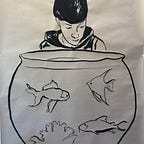An Invitation to Self-Discovery through the Art of Georges Rouault
Miserere Mei: A Journey of Self-Discovery through the Art of Georges Rouault. Joel Klepac 2023.
This three-and-a-half-year journey has been a synthesis of my training in fine art painting, my lifelong passion for the work of Georges Rouault, my development as an Internal Family Systems (IFS) Therapist and my spiritual life rooted in the Hesychast Eastern Orthodox tradition. My hope is that the reader is drawn into the themes of each of the first 33 prints of the Miserere Series. I start each chapter by drawing out the major themes and then through personal stories from living in Romania and ending with guided meditations based on IFS to facilitate the readers self-discovery. Self-judgment, aloneness, numbing, existential questioning, self-righteousness, indifference, fear of hope, doubting, and finding your deeper compassionate state are a few of the themes offered for self-discovery. While Rouault was a devout catholic artist, even his religious themes touch on universal human experiences with which folks from any spiritual or psychological starting point can connect.
Excerpt from the Introduction…
“…In 2004 my family and I traveled from Romania, where we were living
at the time, to visit extended family in the Cleveland area, and I was able to
get to the Cleveland Art Museum. I was indignant that Rouault’s Head of
Christ (c. 1937) was not on display. On our way out the door, I inquired at
the desk whether there was any way to be able to see the painting. I pulled
out my sob story of living in Romania and not being able to get to the
museum normally.
The kind folks asked their management what could be done. They
arranged for me to return in two days, when they would pull the painting out of storage. Upon returning, they took me back to a large office area with a sea of desks. Against the back wall was the painting on a cart, with a folding chair placed in front of it. After spending about 45 minutes in front of the painting, I was invited to the print room. Once there, they gave me latex gloves so I could handle the prints graciously brought to my table.
Upon seeing my enthusiasm, the print curator brought out a large flat
box on a cart. It was a full set of Rouault’s Miserere (1948). The attendant
opened the box and invited me to look through the entire set one by one. I
had seen ten or twenty, but seeing them all in context, in order, on a table in a quiet room was startling. It was a sacred encounter with a piece of the soul of Rouault. I brought into that quiet space of the print room visions of kids I was working with who lived on the street in Romania. Rouault had a way of holding that pain and brokenness, sitting with it, and seeing light beyond it without hurrying out of the darkness.
Twenty years later, I am a marriage and family therapist still fascinated
with the inner life. By means of his work, Rouault continues to sit in the
ashes with parts of myself I would rather disown; he points to people in our
lives who are suffering and says, “Look at that sacred being in front of you.”
The following reflections through the Miserere series are not intended to be scholarly arguments, but rather expressions of my relationship with the work of Rouault. I hope to be true to the spirit of Rouault and somehow testify to the power of art to transcend time and place, race and religion, ideology, and every form of difference imaginable; to speak to the shared experiences of humankind. And despite the very real and beautiful differences found in the human community, through empathy for the other, we can render those differences impotent to cut off our sense of belonging to one another.
Just over 100 years have passed since this work was completed. The
elapsed time has not diminished the power of this work to connect with core human experiences, both the darkness and the unconquerable light.
Saint Isaac the Syrian in the 7th century described “hubba Šapya” as a
love that “cannot be obtained by deeds of philanthropy or, in general, by
human effect; it is a gift which we receive directly from God.” Isaac’s
teaching on how the love of neighbor is acquired can be outlined as follows: a person withdraws himself from his neighbor for the sake of life in solitude and stillness; through this he acquires an ardent love of God; and this love gives birth in him to the “luminous love” (hubba šapya) of humanity.
Many marvel at the reclusive habits of Georges Rouault. He generally
came out of his studio only to eat and to be with his family or a few close
friends. One wonders whether the luminous love for humanity spoken of by St. Isaac the Syrian was not present in Rouault. The way he viewed people is manifest in his depictions of them in his art. His luminous love seems to be seen in his gracious approach to the characters surveyed over his career.
Jacques Maritain (1882–1973), an eminent Catholic philosopher and
close friend of Rouault, wrote that there was in him, “like a spring of living
water, an intense religious sentiment, the stubborn faith of a hermit… which made him discover the image of the divine Lamb in all the abandoned and rejected for whom he felt a profound pity.”
And if, “The world’s worst evil is the fear of loving,” perhaps Rouault
intends an exorcism of fear by his escapades through the darkest parts of the human experience. My hope is that the reader will make their own inner connections with these pieces and make steps towards more freedom from fear to spending more time in the state of compassion...”
